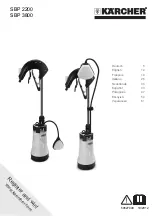
9
Fig 13‐1
Fig 13‐2
The power (motor input power P1) connected to the switch box
sockets may not exceed 2700W in total.
In case of switch overload the overload cut‐off (R) will react.
After approximately 5 minutes of cooling the overload cut‐off
can be reset.
Make sure that the power cord does not impede work and
cause people to trip.
Mains connection and any extension cords used must comply
with applicable regulations.
The mains voltage must comply with the information on the
machine licence plate.
Only use connection cables marked H07RN‐F
The mains connection must have a 16A surge‐proof fuse.
Connections and repairs to the electrical equipment may only
be carried out by qualified electricians.
5.5 Starting operation
Turn the router switch to the ON‐position.
You can now start the machine with the green On‐button on
the magnetic switch (J, Fig 13).
The red Off‐button on the magnetic switch stops the machine.
Both sockets are operated by the switch.
A shop‐vac connected to the second socket will start and stop
together with the router.
6. Machine operation
Workpiece handling:
Feed the workpiece straight across the machine table, holding
your fingers close together, guiding the workpiece with the
palm of your hands.
Never put your hands under or behind the shaper guard.
Always keep your hands well clear of the rotating cutter.
Always feed the workpiece against the cutter rotation (Fig 14).
Adjust the workpiece hold down (D), to guide the workpiece
and to avoid workpiece lifting.
Adjust the lateral workpiece guide (C), to guide the workpiece
and to press the workpiece against the fence.
Fig 14
Use a push block when working the ends of narrow stock.
Workpieces shorter than 200mm require special feeding aids
(e.g. feeding template).
Always machine the workpiece over its entire length.
Recess machining may only be carried out with the aid of
suitable longitudinal workpiece stops (X, Fig 15), to reduce risk
of workpiece kickback.
Fig 15
When working complex shapes, make jigs and guides to guide
the workpiece properly and safely.
Tenoning and slotting work is not allowed – serious risk of
injury!
Make trial cuts on a piece of scrap before working the actual
workpiece.
Support long and wide work pieces with helping roller stands.
Always work one workpiece at a time.
Always hold and guide the work pieces safely during machining.




























